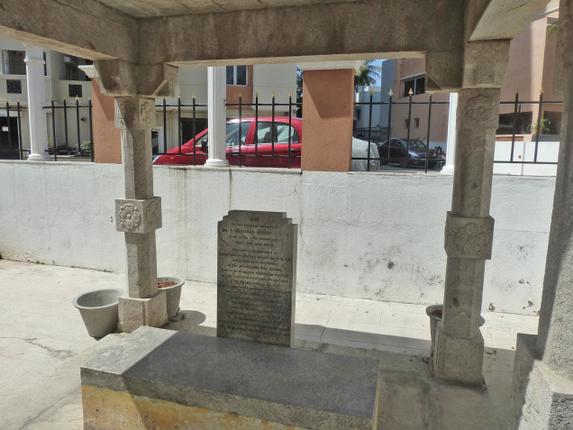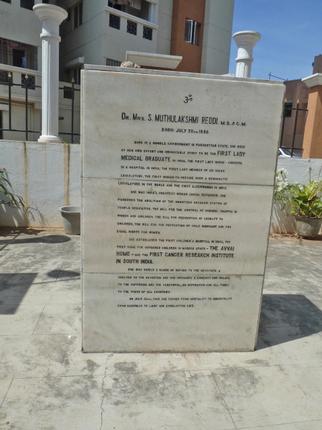
“You need permission,” says the watchman at Ramaniyam Sanjivini, a residential complex in Thiruvanmiyur, and despatches his assistant to call the secretary of the building association. I blink at the CCTV camera, hoping the secretary will take kindly to what he sees. Soon, a couple of dhoti-clad seniors walk toward me. “I need to photograph the memorials of Dr. Sundara Reddy and Dr. Muthulakshmi Reddy,” I tell them. “Historian Narasiah told me I’d find the shrine and the memorials here.” They point to the round-about ahead; a few steps down and I’m face-to-face with the stone memorials — Dr. Sundara Reddy’s under a traditional mandapam and Dr. Muthulakshmi Reddy’s out in the open air.

Dr. Muthulakshmi Reddy deserves more than just an open stone plaque in a private property. Born in the princely state of Pudukkottai on July 30, 1886 to Narayanaswami Iyer and Chandramma (16), a devadasi, Muthulakshmi was one of eight siblings. An exceptionally bright child, she completed schooling from home, fought for higher education, and was admitted to college as the first girl student when the Maharaja passed an order for her to be enrolled. (She sat behind a screen visible to the teachers alone, and left the class while the boys remained seated.) She topped the Intermediate exams, refused to get married and insisted on doing medicine, a decision brought on by her mother’s cancer attack and death of a cousin during childbirth.
In Madras, she met Sarojini Naidu at Dr. Nanjunda Rao’s Mylapore bungalow, and with her attended Annie Besant’s speeches at Adyar, and was drawn to the Home Rule Movement. Having stood first in her Medical degree (MB & ChM) exam, she worked at the Women and Children’s Hospital in Egmore, the first lady house surgeon in Madras’ medical history. She married Dr. Sundara Reddy in 1913.
Meeting the kids in Dr. Vardappa Naidu’s Destitute Home for Boys and Girls on her child’s Vidyabhyasam Day, she vowed to help them. When her youngest sister died of cancer, Muthulakshmi decided to do all she could to tackle the disease. Foregoing her handsome practice, she went to London with her husband and two boys for PG studies. In June 1926, she attended the International Congress of Women in Paris as India’s representative. When she returned, the Women’s Indian Association proposed her name for the Legislative Council and she became the first woman legislator in the Council. She was also the first alderwoman between 1937 and 1939. During her time, the Council passed a resolution giving the right of franchise to women. Her association with a home run by Sister Subbulakshmi brought her close to the plight of women and children, and she piloted the legislation preventing child marriage. Her bill for abolition of the devadasi system was passed after much debate in February, 1929. In 1937, she moved a bill for Inam lands to be given to devadasis. In 1930, when a batch of seven freed devadasi girls were refused accommodation in Madras hostels, she started the Avvai Home to house and train children and young girls, selling her jewellery for its basic facilities. She organised the first Vigilance Association, Rescue Home for Women and supported the Children’s Aid Society.
She resigned from the Council when Gandhiji was arrested in 1929-30. She was then editing Stri Dharma, a journal promoting the national movement. She went as a delegate to London to depose before the Lothian Committee on Franchise and to Chicago to attend the International Congress of Women. In 1935, MMC moved a resolution for a specialised hospital for cancer, but she had to wait to see it happen. After constant campaigning, she collected Rs. 2 lakh and established the Cancer Institute in 1955. She was awarded the Padma Bhushan in 1956. In 1967, she spoke for half-an-hour at the Golden Jubilee celebrations of Women’s Indian Association, her last public speech. She passed away on July 22, 1968.
How did the plaque get there? The land belonged to Dr. Reddy and her son lived there, said Narasiah. After he passed away, the builder purchased it. While researching on Dr. Reddy, Narasiah came to know of the memorial at the residential complex. “I showed Sridhar of Ramaniyam the memorials at the site, and requested him to preserve them along with a shrine where the Reddys used to pray.” It turned out he had already promised Dr. Shantha of the Cancer Institute the memorials would be left untouched. “Dr. Shantha visits it often to see that it is well-maintained,” said the seniors.
source: http://www.thehindu.com / The Hindu / Home> Features> MetroPlus / by Geeta Padmanabhan / March 03rd, 2015